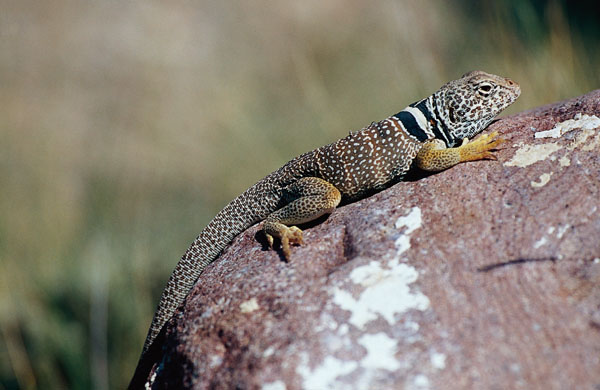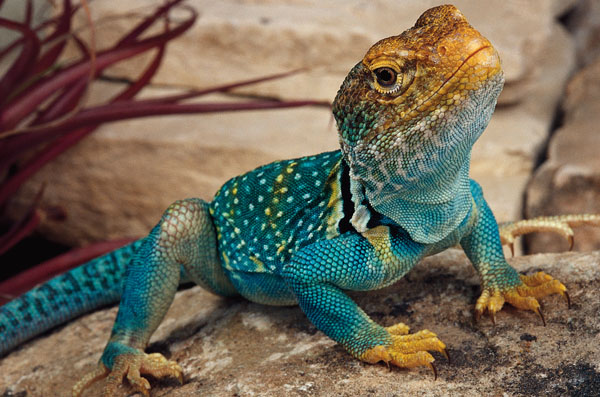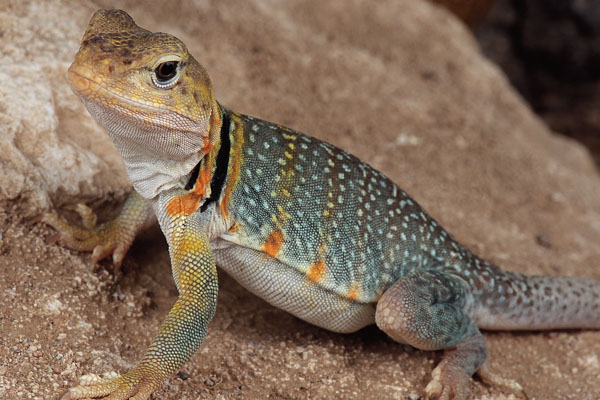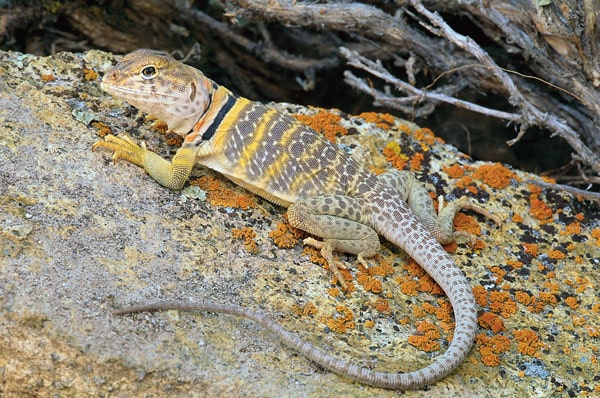Collared lizards are very rewarding captives, and there is nothing cuter than newly hatched baby Crotaphytus.
Large, robust and colorful, the collared lizard (Crotaphytus spp.) makes a welcome addition to any reptile collection. The most common species encountered in captivity is the common collared lizard (Crotaphytus collaris). Less frequently encountered is the Great Basin collared lizard (C. bicinctores). Both species do well under captive conditions and are relatively easy to breed. We have maintained collared lizards for the past 14 years, and one of our females is at least 15 years of age and has produced offspring during her 14th season.
Read More
Burning Down The Forest To Restore The Collared Lizard
Colorful Mating
Males are generally larger than females and have brighter coloration, especially during the breeding season. Females, however, take on a very attractive appearance during mating season, with bright-orange bands becoming evident around the time of copulation. These medium-sized lizards reach 12 to 13 inches, their tail comprising almost 70 percent of that length.

Walter and Gerold Merker
Breeding collared lizards requires that the animals undergo a period of brumation.
Collared Lizards Need Room to Roam
When housing collared lizards, no cage is too large. We utilize several types. When keeping these animals indoors, we use 40-gallon breeder terraria or the medium display enclosure designed by Freedom Breeder for our adult pairs. Various rocks and grapewood are positioned within the enclosure for basking sites. The basking sites are firmly anchored against the base of the terrarium. We often position the basking rocks over a brick, as this will provide a flat surface, and the lizards will not be able to dig below and cause the rocks to become unsteady.
There are a number of good commercial sand substrates available; we use play sand. Paver’s sand can also be used, because the lizards are able to form artificial “burrows” when the substrate is moist. Given that we use sand substrate, we make sure to feed our animals in 8-inch, flat ceramic bowls, so as to minimize the potential for sand impaction.
For lizards housed outdoors, we provide cement enclosures similar to Bert Langerwerf’s design. They measure 40 inches long, 30 inches wide and 20 inches tall. These cages are built on a 3-inch-thick concrete slab. Cinder block is utilized to build the enclosure’s sides and retaining back wall. Wire and screen are used on the top and front to prevent the lizards from escaping. The screen front is removable to allow for easy cleaning with a garden hose. A small access hatch in the front screen door allows us to feed the animals without having to remove the entire screen. At the bottom of the enclosure’s rear retaining wall are two, 4-inch ABS plastic tubes built into the wall and capped so that the lizards cannot escape. These tubes are positioned one on each side of the back wall and are covered under approximately 22 inches of dirt. They act as a heat sink, retaining warmth in the winter and coolness in the summer. Animals can escape the summer heat and the winter cold in these tubes. Inside the tubes, a small mix of dirt, vermiculite and sand is used as a substrate the animals can burrow into if necessary. With the addition of this substrate, lizards can utilize these tubes as nest sites as well.
As with indoor enclosures, various rocks and pieces of grapewood are placed in the enclosure to give the animals several options for perching to bask and observe their surroundings. There really is no supplement for natural sunlight, and these outdoor cages provide numerous hours of high-intensity sunshine each day.
Collared Lizard Lighting Tips
Full-spectrum lighting is absolutely imperative to the long-term health and breeding of these animals. UVB radiation can be provided in the form of either a fluorescent bulb or a mercury vapor bulb for lizards housed inside. If using a fluorescent lighting source, a basking bulb will be required to provide adequate heat. A mercury vapor bulb is ideal in that it provides both UVB radiation and heat. Collared lizards should have access to high temperatures of approximately 105 degrees Fahrenheit, but the ambient temperature within the terrarium should not be higher than 84 degrees. It is a good idea to gently mist the terrarium with warm water at least once a week to maintain adequate hydration. Relative humidity within the terrarium should remain between 30 and 50 percent. It is also a good idea to have humid hide areas, much like these animals would encounter in the wild. Avoid spraying close to the incandescent bulb to prevent the bulb from bursting.
Collared Lizard Feeding Tips
Feeding collared lizards is usually easy, as they have a voracious appetite. A poor appetite should be a tip-off that an animal may be sick or that husbandry parameters need to be altered (for example, heat should be increased or the number of animals in the enclosure decreased). Food should be provided in the form of insects, the occasional pinkie mouse and fresh fruits and vegetables. Crickets form the majority of the diet, with other insects, such as silkworms, Phoenix worms, mealworms, hornworms and Turkistan bullet roaches (Blatta lateralis) being offered less frequently. We generally feed roughly four to five crickets per lizard at least every other day. Once a week we offer other insects for variety. We also offer a small salad of brightly colored fruits, vegetables and flowers once a week. We have had good luck using grated carrots, yellow squash, zucchini, chopped strawberries, grapes and Nasturtium species. In our group enclosures, the more aggressive feeders are occasionally removed from the cage at feeding time to allow the more timid individuals the opportunity to feed.

Walter and Gerold Merker
Collared lizards are a group of North American lizards usually found in arid regions of the western two-thirds of the United States and northern Mexico.
Breeding Collared Lizards
We keep our breeding collareds together year round. Some are kept as pairs and others are one male with up to three females in an enclosure. Breeding collared lizards has proven challenging for us. We have produced over 20 viable clutches in the past 10 years; however, we have had just as many clutches that did not go full term. Our poor results are due in part to not having enough moisture in the hiding tube substrate within the outdoor enclosures and eggs drying out as a result.

Walter and Gerold Merker
Unlike other lizards, collared lizards do not autonomously drop their tails. The tail is, in fact, very important to the locomotion of these animals when engaged in bipedal sprints across the desert. It helps them keep their balance and maintain their momentum.
Breeding collared lizards requires that the animals undergo a period of brumation, as they do in the wild. We allow our lizards to cool naturally during the winter months. In California, where we live, summer ranges between the low 60 and 100-plus degrees Fahrenheit, and winter temperatures are anywhere from the low teens to the mid 30s (degrees). The lizards in our outdoor enclosures generally do not come out of their hide areas once the daily high temperatures fall below approximately 65 degrees.
Lizards undergoing a cooling period must not have food in their intestines. To accomplish this, maintain lizards at higher temperatures for 10 to 14 days before the cooling period. This allows them to digest their food and void waste before cooling.
The lizards we maintain outdoors are cooled for up to six months with minimal weight loss. When lizards come out of brumation in the spring, they must feed, breed and lay eggs during a six-month activity period. Our outdoor captives usually produce only one clutch of eggs yearly (usually by late July or early August) because of the short growing season in which the lizards can be active, feeding and breeding.
Collared Lizards Are Aggressive Breeders
Collared lizards must be closely monitored during breeding season, as males can be very aggressive. Mating typically consists of the male grasping the female by the neck, which can result in superficial lacerations. It is important to use similar-sized individuals and monitor the animals closely for bite marks or weight loss. In more severe cases, the male may attack and even cannibalize a smaller female.
Breeding lasts for usually one to two months, unless the female double clutches. If she does double clutch, add another five weeks or so to the breeding season. There are usually three to eight eggs in a clutch. On average, eggs are laid three to four weeks after copulation. It is a good idea to have an appropriate nesting area available, as copulation is not always witnessed and gestation periods can vary.
Collared Lizard Incubation Prep
We use half-gallon Rubbermaid plastic bins measuring 11 inches long, 5 inches wide and 11⁄2 inches tall for incubation containers. The top is covered with a lid and 30 or more holes measuring a quarter inch in diameter are poked through the side. Substrate consists of a mix of moist coco coir, peat moss and play sand. Excess water is squeezed from the substrate so that the eggs do not become too wet. Successful incubation of collared lizard eggs can occur in a variety of substrates. We have used HatchRite, vermiculite and perlite with equal success.
The incubator is set at 84 degrees. If eggs are fertile, they usually hatch within 55 to 65 days. As far as we can tell, temperature does not determine sex. However, we have not experimented with this. Most of our clutches are half male and half female.
Collared Lizard Hatchling Care
Hatchlings are best housed in large terrariums. A 40-gallon breeder terrarium can easily house up to 10 individuals. As the animals grow, they should be separated in order to prevent aggression between clutchmates. A paper towel substrate is ideal, as this will prevent the accidental ingestion of sand or small pebbles. Place a number of rocks and pieces of grapewood within the terrarium to serve as basking sites. Provide hatchlings with the same temperatures and humidity you would give adults. It is especially important that they have moist hides where they can escape high temperatures if need be. Feed hatchlings one or two week-old crickets a day.
In our experience, sexual maturity is attained in roughly two years. At 6 months old, we provide the collareds with access to natural sunlight by placing them in outside enclosures that measure 30 inches long, 11 inches wide and 11 inches tall. An enclosure of this size can house four hatchlings. Animals are monitored to make sure they do not become overheated. Continuous gaping and attempting to escape the cage on the cool end are signs that a lizard is overheating. Cage design incorporating shade and moist hides into part of the enclosure will help prevent overheating.
Collared lizards are very rewarding captives, and there is nothing cuter than newly hatched baby Crotaphytus. Unfortunately, the vast majority of available collareds are still wild caught. Captive-bred collared lizards are available only on a very limited basis. Each year, we become more successful in our efforts to maintain and breed these lizards in captivity, and we hope that this guide will help others to succeed as well.
GEROLD MERKER has a bachelor’s degree in zoology from the University of California, Davis, and a master’s in biology from U.C. Riverside. A teacher and photographer, he has authored or co-authored numerous reptile and amphibian articles, many of them appearing in REPTILES and Reptiles USA.
WALTER MERKER graduated from the University of California, Santa Cruz, with a degree in molecular, cellular and developmental biology. In addition to writing reptile articles, he works in an avian and exotic veterinary clinic, and he plans to pursue a degree in veterinary medicine.


